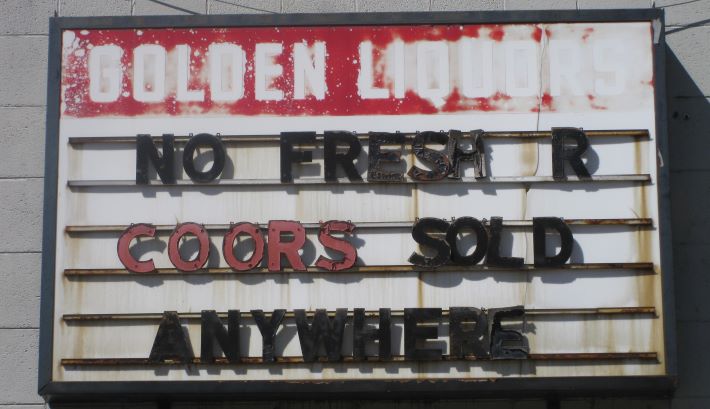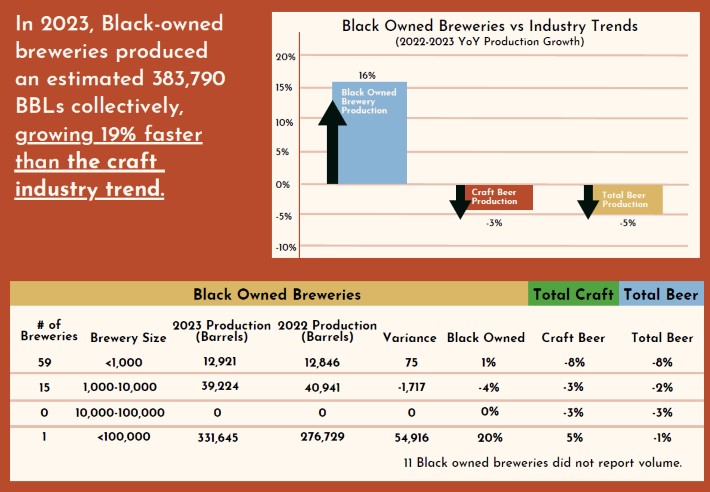
This photo was taken during a 2009 visit to Golden, Colorado. The sign has changed, but the message is the same today at Golden Liquors. The Coors brewery is located across the street from the store. Coincidentally, we now live within the Golden ZIP code, but not the town. Read more about Coors below.
QUESTION OF THE WEEK
Is beer really just the sum of its molecular parts, or is there an intangible aspect that can’t be emulated by a machine?
— Posed by Evan Rail early in “A High-Tech ‘Beer Printer’ From Belgium Wants to Digitize the Drinking Experience.”
Rail writes that the company has “presented a fully operational prototype, called ‘OneTap,’ that can pour five different styles of beer, as well as custom brews users can adjust to their preferences. Since then, members of the public have been able to sample lager; blonde, brown, and triple ales; and IPA made by the small countertop device at trade fairs and other events in Belgium.”
And some people within the brewing trade have been impressed.
I talked with Rail before he wrote the story—you’ll find me quoted— so I had a head start for thinking about how authentic these beers might taste. I’ve been writing about efforts to digitize beer aroma and flavor for about (checks notes) 10 years. In those cases, companies focused on recommendation systems that might have been similar to Netflix, Spotify or Pandora. The fact that these companies have come and gone, or gone on to something else, provides proof of how difficult the task is. Before even trying to turn data into beer.
Otherlands’ Songs of Courtship, a festbier made to celebrate the brewery’s anniversary, proved to be a perfect beer to consider the question Rail asks early on. I drank Songs of Courtship on consecutive days earlier this month at the brewery-restaurant in Bellingham, Washington, and the first time “Modern Lager Beer” was on my mind. In it, the authors write, “Over and over again, lager brewers emphasized to us the importance of their process to the finished quality of their beer.”
Process is complicated. The result can be a complex beer that does not taste complicated. That was Songs of Courtship.
In his story, Rail quotes a well known Belgian beer expert: “The beers were clean, they were to style. They were good. But for me, there was no depth. There was no complexity.”
An endorsement, but not an endorsement. That might be enough to make OneTap a viable commercial product. Luckily for them, they don’t need my money to succeed.
MOST INTERESTING NUMBERS OF THE WEEK

The National Black Brewers Association has released the “State of Black Brewers, 2024.” You may download the 12-page pdf here.
TASTING NOTE OF THE WEEK
There’s nothing in any way spectacular about it, but it’s very good: lots of wholesome, well-balanced flavour in a very straightforward and easy-drinking package. I’ve mentioned before how much I’d like dark lager to be more commonplace in these parts. This is a perfect example of what I’m talking about it. This should be distributed out beyond the speciality imports market.
— The Beer Nut describing Ksiazece Czerwony.
LEDE OF THE WEEK
In some ways, Brasserie de la Mule resembles other new breweries in Brussels. Its home is a 19th-century, brick-and-stone building in the Belgian capital’s lively, multicultural Schaerbeek area, once used as a stable for the horses that pulled the city’s first trams, hence the name. Its taproom is an elemental space of bare brick walls: air ducts running the length of the ceiling, wooden cable drums on their sides acting as tables, battered but comfortable-looking sofas in one corner, and a general air of decorative disarray. At first glance, it looks like a generic craft taproom, whose aesthetics can be seen elsewhere in the city at the likes of Brasserie La Jungle and CoHop.
However, the chalked-up beer list hanging behind the bar tells a different story from the one you would expect: The words helles, lager, and pils suggest that there is something unique going on. Alone in the Belgian beer scene, Brasserie de la Mule specializes in producing German-style beers, especially those from the family of lager.
— From Bavarian Beer Culture and the Dash of Decoction Mashing in Good Beer Hunting
FUTURE READING
Sunday on Bluesky Social, Boak & Bailey wrote, “The newsletter is drafted. It’s about the state of beer writing in 2024. We now need to go to the pub and argue about it a bit before we edit/proofread/send in the next day or so.” You will probably be able to find it here.
YOU MIGHT ALSO ENJOY
Real ale wars! Camra and the bitter battle over the future of beer. On X, Pete Brown wrote, “It’s rare any writer gets given 3000 words in a national newspaper. Never happened to me before. So am delighted to have a huge piece on @CAMRA_Official in today’s Sunday Times. Hope people see it as fair and balanced. I was certainly much fonder of CAMRA after writing it.” It is behind a paywall, but perhaps you (too) know away around it.
– Real ale could do with a little democracy. The final sentence could have been “kicker of the week.” Do read it, but don’t just skip to the end. “Democratic with your praise.” An interesting notion.
– Beer and nostalgia. I confess to being guilty in the past of using the term “beer-flavored beer,” but I should not have. There should be a better way to refer what some would call “classic flavors.” For many consumers, the fruity, even soda-like, flavors in hazy IPAs are “beer-flavored beer.” That’s an aside. This is a story about the recent surge in sales of Coors Banquet.
– Cultural Exchange. “Fuji to Hood or Hood to Fuji, depending on the host country—has consistently been one of the most interesting festivals staged in the United States.”
– Brewery Excess Capacity Means More Beer! Really. Contract brewing 1996 = bad. Contract brewing 2024 = why not?
NEVER FORGET
The Gothamist posted a story last week about line-sitters in New York. It brings back memories from more than a half dozen years ago when Wall Street bros paid other people to wait in line to acquire Other Half beers. And, of course, the time only a month before the pandemic shut down New York that a “craft beer hater” pulled a gun on people standing in line at Other Half.
I don’t know enough about advertising and product placement and social media to know if the reasons for Coors Banquet growing like crazy is what Dave Infante says — I think Hamm’s and PBR and Schlitz also saw crazy increases in years past before sliding back down or stabilizing w/o planned marketing and accidental endorsements backed by cable news. But I do think Banquet is the closest thing the classic macro brews have to a true brewed-in-one-place, care-taken-at-each-step (well, maybe not if they no longer ship in refrigerated trucks to ensure it stays cold until it reaches its destination).
Hopefully a fun story: I was a teenager in New Hampshire when Coors went national, and we all had heard the mystique and awaited our change to (of course, illegally) try the beer. But Canadian beers from Labatt’s and Molson and Moosehead were the brews of choice in my neck of the woods rather than Bud and High Life, so when we finally got our hands on a sixer of Coors, we were someone underwhelmed, because compared to what we were used to drinking, Coors was pretty mild, flavor-wise. A good example of hype and anticipation not always paying off. With a wider palate now forty-odd years later, I enjoy Banquet when I have one, but still remember the puzzled looks on my friends’ faces (and likely on mine) when we had our first taste back then.
As a Midwesterner, the comparison was between Stroh’s — which, honestly, was appreciated for its low price as well as flavor — and Coors. The result was the same.